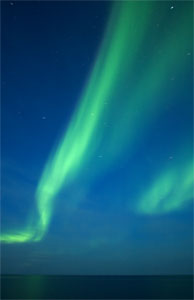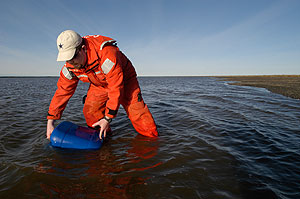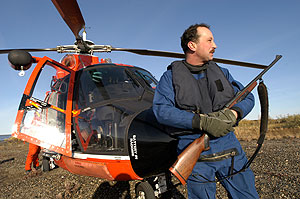|
|
 |
 |
 |
| The spectral light of the aurora borealis lights up the evening sky. |
Click to enlarge
|
Daily Update
Calendar
Dispatch 06 - September 6, 2004
By C. A. Linder
Weather conditions: Clear skies, 15 kt winds, calm seas, air
temperature 42° F
Lights and Flights
Last night at midnight I was in typical form--headphones on, hunched over my laptop rushing to finish Dispatch 05. I have set up my laptop in the main lab, just behind the Board of Lies where I can watch all of the action. The main lab is unfortunately not graced with any views of the outside world... The best we have is a television monitor hooked up to a series of closed-circuit cameras located throughout the ship. So, we can watch the waves go by on TV but that's about it. That is why Bob Pickart took me by complete surprise when he came running into the main lab with his news:
"Aurora borealis--bring your camera!"
It took me a few moments to gather my tripod and cameras and then I was outside the ship scanning the sky. Sure enough, a thick ribbon of bright green light was arcing up from the horizon (which was still not completely dark, even at midnight!) The sky was clear and the Big Dipper was shining brightly in the cobalt blue sky. Dan Torres, Bob Pickart, Leopoldo Llinas, Ryan Frazier and I stood on the flight deck watching the auroral display. The green light flickered and waved, sometimes appearing bright and distinct, other times fading to a light green haze. Eventually the cold (& exhaustion) drove us back inside. By then it was nearly 2am.
 |
 |
| Jeremy Mathis braves the freezing cold, muddy waters of the Colville River for science. |
Click to enlarge
|
This morning found us just offshore of the town of Barrow,
Alaska. The Queen of Data Processing (Sarah Zimmermann) and the King
of Moorings (John Kemp) have been waiting in Barrow, Alaska for the
past few days for us to pick them up. They have just come from another
research cruise on the Canadian icebreaker Louis S. St. Laurent.
To see what they did on their cruise to the central Beaufort Sea (many
miles northeast of our current location) check the dispatches on the
Beaufort Gyre Exploration
Project website.
Sarah and John have arrived just in time. Sarah is responsible for processing the CTD data and John is the leader for recovering the WHOI moorings. Our CTD sampling will be starting later today, and the mooring recoveries will be starting in a few days, so they don't have much time to get settled.
 |
 |
| LTJG Kenny Eller keeps an eye out for polar bears while the water samples are loaded. |
Click to enlarge
|
This afternoon, Jeremy Mathis made another trip to sample river water. This time
he went to the Colville River, which empties into the Beaufort Sea.
I was lucky enough to be able to accompany Jeremy and the flight crew
out to the river to document the adventure. Anytime you get in a helicopter
I believe "trip" or "flight" just isn't a satisfactory description.
"Adventure" is much more appropriate. The takeoff alone is worth the
trip. There you are on the flight deck,
and the next minute the waves are racing by underneath you. Pilots
LT Klatt and LTJG Eller guided us to the mouth of the Colville River
and we followed it upstream to find a suitable spot to land. The first
promising chunk of land was actually a small island in the river.
As we circled closer, Petty Officer Jim Holt noticed something about
this particular island... "Bear tracks--let's
not land just yet." We instantly pulled up and circled the island
to make sure it was really uninhabited. After verifying that the island
was bear-free, we landed on a patch of gravel. Jeremy and Jim collected
the river water while I photographed and Kenny Eller stood watch for
bears. The last thing we wanted to see at this point was a polar bear.
After loading the samples, we blasted off again and made our way back
to the Healy. Along the way we flew over small herds of caribou
grazing on the tundra.
Science
Crew Facts

Ellen Naughter lives
on a 39' sailboat named Eventyr with her boyfriend
Alex. |  |
Meanwhile, over 70 miles to the north, the rest of the science crew
was very busy on the Healy.
We have now started a north-south section across the Beaufort shelf,
making full measurements at each science station. The main lab, yesterday
a ghost town, is now a hub of activity. This section will take a few
days to complete, and then the mooring recoveries will begin.

|
Traducido al Español por Mifaya |
Luces y vuelos
La medianoche pasada estaba con los cascos puestos delante de mi ordenador, corriendo para terminar el comunicado numero 5. He puesto mi portatil en el laboratorio principal detras del “panel de mentiras” (donde esta escrito el plan diario) desde el cual puedo ver toda la accion. El laboratorio principal no tiene vistas al exterior…lo mejor que hay es un monitor de television conectado a un circuito cerrado de camaras que hay distribuidas por todo el barco. Asi que podemos ver las olas a traves de television pero ya esta. Por eso, Bob Pickart me sorprendio cuando vino corriendo al laboratoio y me dijo:
“Hay Aurora Boreal, coge tu camara!”
Tarde unos minutos en coger el tripode y las camaras y me quede fuera observando el cielo. Una ancha franja de color verde formaba un arco desde el horizonte (que pese a ser medianoche aun no estaba del todo oscuro!). La noche estaba abierta y la Estrella Polar brillaba en el cielo azul cobalto. Dan Torres, Bob Pickart, Leopoldo Llinas, Ryan Frazier y yo, permanecimos en la pista del helicoptero observando la exhibicion de la aurora boreal. La franja verde parpadeaba y ondulaba, a veces apareciendo nitida y otras, desvaneciendose en una neblina verde. De vez en cuando, el frio (y el cansancio) nos hacia entrar al barco. Asi estuvimos hasta cerca de las dos de la madrugada.
La manaña nos encontro cerca de la ciudad de Barrow, Alaska. La Reina del Procesamiento de Datos (Sarah Zimmermann) y el Rey de los Moorings (John Kemp) han estado esperando en Barrow unos dias para que los recogiesemos. Ellos acaban de volver de otra expedicion oceanografica a bordo del rompehielos canadiense Louis S. St. Laurent. Para ver lo que hicieron en su expedicion en el centro del Mar de Beaufort (muchas millas al noreste de nustra posicion actual) consulten la pagina web del Beafourt Gyre Exploration Project.
Sarah y John han llegado justoa tiempo ya que Sarah es la responsable de procesar los datos de la CTD y John es el lider en recogida de moorings. Los muestreos de CTD empezaran al mañana al final del dia y la recogida de moorings comenzara dentro de unos dias, asi que no disponen de mucho tiempo para acomodarse.
Esta tarde Jeremy Mathis hizo otro viaje en helicopero para recoger
muestras de agua de rio, esta vez del rio Colville que vierte al Mar
de Beaufort. Fui afortuando por poder acompanar a Jeremy y a los pilotos
y asi poder documentar la historia. Cada vez que subo a un helicoptero
pienso que la palabra “viaje” o “vuelo” no describe suficientemente
lo emocionante que es. “Aventura” es una palabra mas apropiada. Lo
mejor es cuando despega: estas en la pista
de aterrizaje y el minuto siguiente estas viendo las olas debajo
de ti. Los pilotos LT Klatt y LTJG Eller nos llevaron a la desembocadura
del rio Colville y lo badeamos hasta encontrar un sitio apropiado
para aterrizar. El primer sitio disponible era una pequena isla en
mitad del rio. Mientras nos acercabamos, el marinero Jim Holt notifico
algo importante acerca de la isla: "huellas de Oso-no aterricemos
aqui por el momento!" Volvimos a subir y rodeamos la isla varias
veces hasta estar seguros de que estaba deshabitada y aterrizamos
en una zona de grava. Jeremy y Jim recogieron las muestras mientras
yo fotografiaba y Kenny Eller vigilaba por si aparecian osos porque
la ultima cosa que queriamos ver era un oso polar. Tras recoger las
muestras volvimos al Healy sobrevolando pequemos rebaños
de caribou que pastaban en la tundra.
Mientras tanto, 70 millas al norte, el resto de la tripulacion de
cientificos permanecian muy ocupados
en el Healy. Hemos comenzado una seccion Norte-sur sobre
la plataforma continental del mar de Beaufort, realizando analisis
y medidas en cada estacion. El laboratoio principal, ayer un pueblo
fantasma, es ahora un hervidero de actividad. Tardaremos unos dias
en completar esta seccion y tras ello, comenzaremos a recoger los
moorings.
 Previous
Dispatch
Next Dispatch Previous
Dispatch
Next Dispatch

Back to Calendar
|
|




